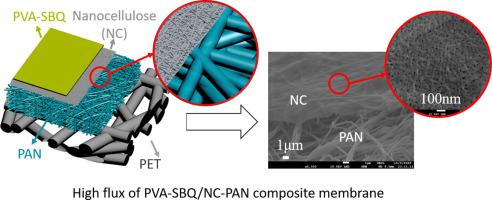Desalination ( IF 8.3 ) Pub Date : 2021-05-08 , DOI: 10.1016/j.desal.2021.115128 Junquan Meng , Pengbo Zhao , Bing Cao , Cher Hon Lau , Yunlong Xue , Rui Zhang , Pei Li

|
Pervaporation (PV) is a low-energy membrane separation technology widely studied for desalination, water treatment and solvent recovery where heat is applied to vaporize the feed solution and a vacuum is applied at the permeate side to drive the separation of miscible mixtures. The heart of this technology – polyvinyl alcohol (PVA) that is commonly used as the separation layer of polymer membranes is often fabricated over long cross-linking durations, high temperatures or toxic cross-linkers to prevent it from being dissolved in water. Here we overcome these intrinsic material limitations with a photo-crosslinkable polymer, poly(vinyl alcohol)-stilbazol quaternized (PVA-SBQ), commonly deployed in the printing industry, as the dense selective layer of a thin-film composite PV membrane. The separation performances of the resultant PVA-SBQ/nanofiber thin-film composite membranes were optimized as a function of photo-crosslinking conditions where ultra high water fluxes of 122.6 ± 10.8 kg·m−2·h−1 were achieved while desalinating 3.5 wt% NaCl from water at 75 °C and a permeate pressure of 100 Pa. This high PV desalination performance was also maintained during brine (containing 10 and 20 wt% of NaCl) treatment.
中文翻译:

通过光交联制备用于全蒸发脱盐的薄膜复合膜
全蒸发(PV)是一种低能量的膜分离技术,已广泛用于脱盐,水处理和溶剂回收,其中通过加热使进料溶液汽化,并在渗透侧施加真空以驱动可混溶混合物的分离。该技术的核心–聚乙烯醇(PVA)通常用作聚合物膜的分离层,通常是在较长的交联时间,高温或有毒的交联剂下制造的,以防止其溶于水。在这里,我们通过光可交联的聚合物聚乙烯醇-季戊唑季铵化(PVA-SBQ)克服了这些固有的材料局限性,通常在印刷行业中将其用作薄膜复合PV膜的致密选择层。当在75°C和100 Pa的渗透压下从水中脱盐3.5 wt%的NaCl时,获得了-2 ·h -1。在盐水(包含10和20 wt%的NaCl)处理期间,也保持了这种高PV脱盐性能。











































 京公网安备 11010802027423号
京公网安备 11010802027423号